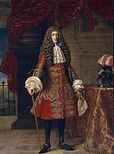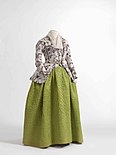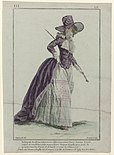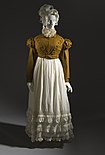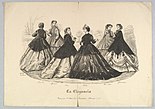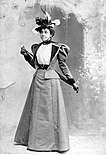В наши дни пальто стало неотъемлемой частью женского гардероба, как весенне-летнего, так и осенне-зимнего времени года. Сотни моделей на любой вкус и цвет, даже для самой капризной леди. Сложно представить витрины магазинов без модных пальто, скроенных по последним тенденциям, согласитесь? И, конечно, не случайно эта вещь из верхнего гардероба стала настолько популярной, к этому конечно вела довольно длинная история. Приглашаю рукодельниц и любопытных любителей узнать что-то новенькое, отправиться в прошлое и посмотреть, как менялась мода, а заодно, и почерпнуть идей для вдохновения!
История берет свое начало в XVIII веке во Франции. Слово «пальто» произошло от испанского слова «пальтоке» (исп. palletoque), которое было образовано при помощи двух основ — pallium (просторный плащ) и toque (головной убор). Такую одежду носили в начале XVI века испанские крестьяне, позже она «перекочевала» в Голландию, которая в то время находилась под сильным испанским влиянием. «Пальтоке», немного изменив название (гол. palastrock), стал элементом одежды придворной знати. Именно такое «Пальтоке» было привезено Маркизе де Помпадур — женщине, которую можно считать первой, кто сделал пальто неотъемлемой частью своего гардероба. Занимаясь одним из своих любимых дел, она несколько изменила крой одежды, сделав его более изящным и женственным.
Новая модная тенденция распространялась с невиданной быстротой! Конечно, какая леди может жить без сплетен о новой одежде 
В России пальто приобрело популярность лишь к концу XIX века, когда женщины начали копировать мужскую моду. Силуэты имели «лубочный» крой — прямые линии и практически полное отсутствие талии.
В XX веке приходит мода на более длинные пальто. Силуэт немного изменился: плечи стали мешковатыми, рукава укоротились, полы закруглились к низу. Шили пальто из плюша, фетра, парчи или бархата с рисунком. Зимние пальто делали из толстой английской шерсти, гладкой или в клетку, украшали длинноворсовым мехом по воротнику и подолу. Зимой пальто носили с длинными меховыми шарфами, муфтами и маленькими шапочками, украшенные перьями. В нарядных пальто воротник часто делали из гипюра, в повседневных — из бархата. Все пальто шили на подкладке из шелка или сатина, а если подкладки не было, швы обрабатывались тесьмой. Застегивали пальто на крупные пуговицы, а петли делали из витого шнура. Как видите, мастерицы не стеснялись придумывать что-то новое и делать верхнюю одежду необычной и красивой. Из простого мешковатого плаща пальто превратилось в невероятно модную одежду.
С появлением огромного разнообразия тканей и фурнитуры, модели верхней одежды менялись каждое десятилетие до неузнаваемости. Известные дизайнеры диктовали новые модные тенденции всему миру.
В 40-е годы появились пальто покроя принцесс — узкие в талии и слегка расклешенные к низу. Носили такие полупальто в комплекте с юбками из такой же ткани.
На пик популярности в 50-е выходят яркие и прямые мини-платья. Эта мода сразу отразилась и на пальто. Они приобрели четкий крой и насыщенность цветовой гаммы. Длина пальто снова стала короткой, воротники объемными. Моду на подобные модели ввел знаменитый кутюрье Кристиан Диор. Кстати, именно благодаря Диор, кожаное пальто стало не только мужской, но и женской частью гардероба.
В 60-е годы резко мода на пальто круто изменилась, и популярны стали сочетания макси-длины пальто с мини-длиной платья. Такой стиль в одежде предполагал определенных дополнений: высоких по колено сапог, объемных сумок на ремне, цветных длинных шарфов или шейных платков. Металлические пуговицы в два ряда, «молнии», пряжки, шпоры стали необходимой фурнитурой. В первую очередь пальто создавались удобными для повседневной носки, одежда сочетала в себе комфорт и красоту, при этом выглядя довольно просто. Большое внимание уделялось аксессуарам.
70-е годы — время возвращения утонченности 40-х годов. Но при этом дизайнеры старались придумать нечто новое и пальто приобрели большие накладные карманы и меховой воротник. Длина пальто была чуть ниже колена. В моду вошли оттенки коричневого и другие теплые цвета.
В восьмидесятые года стерлись рамки между женским и мужским стилем. В моду вошел «унисекс», сочетающий в себе безвкусные цвета, блеск и не имеющие формы вещи. Возрос спрос на спортивный стиль, и женщины предпочли носить полупальто длиной выше колена. Часто они были в крупную клетку или яркого цвета, с поясом для обозначения линии талии.
С 90-х годов и до современности мода постоянно менялась, то возвращаясь к прошлому, то придумывая новые тенденции. Сейчас на перечисление одних только видов кроя пальто уйдет, наверное, несколько страниц текста мелким шрифтом.
Вот только основные из них:
Даффлкот (англ. dufflecoat) — прямое полупальто с застежками из навесных петель, шьется с традиционной клетчатой подкладкой.
Честерфилд (англ. сhesterfield) — приталенное черное пальто с вельветовым или бархатным воротником. Выполняется в классическом черном, а также сером цвете, с узором «елочка». Часто имеет потайную застежку и четыре кармана — два справа (один над другим), один слева и один нагрудный.
Коверкот (англ. covertcoat) — короткое узкое однобортное пальто, вариант одежды для верховой езды и охоты. Отличительной особенностью являются четыре декоративных шва на манжетах и по нижнему краю.
Пальто с запáхом — запашное пальто с поясом.
Пальто кокон (англ. cocooncoat) — свободное пальто, сужающееся книзу.
Копар — длинное кожаное пальто.
Манто (англ. lady’sfurcoat) — широкое женское меховое пальто с расходящимися полами.
Реглан (англ. raglancoat) — пальто с рукавом, составляющим с плечом одно целое. Такой тип одежды был сшит на заказ для английского фельдмаршала.
Ласточкин хвост (англ. swallow—tailcoat) — пальто в котором передняя часть значительно короче задней узкой и длинной части.
Лоден (англ. lodencoat) — длинное широкое пальто с отложным или стоячим воротником. Традиционный вариант шьется из шерсти альпийских овец. Является национальной тирольской одеждой с XVI века.
Полупальто (англ. carcoat) — короткое пальто, длина которого обычно достигает середины бедра.
Пальто-Поло (англ. polocoat) — классическое американское пальто свободного покроя, внешне напоминающее рубашку-поло.
Сваггер (англ. swaggercoat, swingcoat) — длинное широкое женское пальто, расширяющееся книзу и напоминающее по форме трапецию.
Шинель (англ. greatcoat, overcoat) — двубортное пальто со «стоящими» лацканами, эполетами на плечах и кожаными пуговицами.
Пардесю (фр. pardessus) — классическое двубортное пальто с английским воротником и накладными карманами.
Пальто в стиле Нью Лук (англ. newlookcoat) — женское приталенное пальто с пышным расклешенным подолом, вошедшее в моду в 50-х годах благодаря Кристиану Диору.
Пыльник — легкое летнее пальто, изготовленное из хлопчатобумажной или шелковой ткани, модное в 30-е и 50-е годы XX века.
Редингот (англ. redingotecoat) — длинное приталенное пальто широкого покроя.
Пальто во французском стиле — женская модель пальто, иногда с капюшоном, свободным силуэтом и укороченными рукавами.
В заключение, некоторые модные тенденции пальто 2017 года.
Экскурс по страницам истории моды подошел к концу. Большое спасибо за внимание! Желаю творческих успехов 
Not to be confused with Overcoat, a garment meant solely as an outer garment.
A coat typically is an outer garment for the upper body as worn by either gender for warmth or fashion.[1] Coats typically have long sleeves and are open down the front and closing by means of buttons, zippers, hook-and-loop fasteners, toggles, a belt, or a combination of some of these. Other possible features include collars, shoulder straps and hoods.
Etymology[edit]
Coat is one of the earliest clothing category words in English, attested as far back as the early Middle Ages. (See also Clothing terminology.) The Oxford English Dictionary traces coat in its modern meaning to c. 1300, when it was written cote or cotte. The word coat stems from Old French and then Latin cottus.[2] It originates from the Proto-Indo-European word for woolen clothes.
An early use of coat in English is coat of mail (chainmail), a tunic-like garment of metal rings, usually knee- or mid-calf length.[3]
History[edit]
The origins of the Western-style coat can be traced to the sleeved, close-fitted and front-fastened coats worn by the nomads of the Central Asian steppes in the eleventh century, though this style of coat may be much older, having been found with four-thousand-year-old Tarim mummies.[4] The medieval and renaissance coat (generally spelled cote or cotte by costume historians) is a mid-length, sleeved outer garment worn by both men and women, fitted to the waist and buttoned up the front, with a full skirt in its essentials, not unlike the modern coat.[5]
By the eighteenth century, overcoats had begun to supplant capes and cloaks as outerwear in Western fashion. Before the Industrial Revolution, which began in the second half of the eighteenth century, the extremely high cost of cloth meant certain styles of clothing represented wealth and rank, but as cloth became more affordable post-industrialization, people within a lower social class could adopt the fashionable outdoor wear of the wealthy elite, which, notably, included a coat.[6] In the nineteenth century, the invention of the sewing machine paired with existing textile machinery increased the affordability of mass-produced, ready-to-wear clothing and helped spur the popularity of wearing coats and jackets.[7] By the mid-twentieth century the terms jacket and coat became confused for recent styles; the difference in use is still maintained for older garments.
Coats, jackets and overcoats[edit]
Overcoat (left) and topcoat (right) from The Gazette of Fashion, 1872
In the early 19th century, Western-style coats were divided into under-coats and overcoats. The term «under-coat» is now archaic but denoted the fact that the word coat could be both the outermost layer for outdoor wear (overcoat) or the coat is worn under that (under-coat). However, the term coat has begun to denote just the overcoat rather than the under-coat. The older usage of the word coat can still be found in the expression «to wear a coat and tie»,[8] which does not mean that wearer has on an overcoat. Nor do the terms tailcoat, morning coat or house coat denote types of overcoat. Indeed, an overcoat may be worn over the top of a tailcoat. In tailoring circles, the tailor who makes all types of coats is called a coat maker. Similarly, in American English, the term sports coat is used to denote a type of jacket not worn as outerwear (overcoat) (sports jacket in British English).
The term jacket is a traditional term usually used to refer to a specific type of short under-coat.[9] Typical modern jackets extend only to the upper thigh in length, whereas older coats such as tailcoats are usually of knee length. The modern jacket worn with a suit is traditionally called a lounge coat (or a lounge jacket) in British English and a sack coat in American English. The American English term is rarely used. Traditionally, the majority of men dressed in a coat and tie, although this has become gradually less widespread since the 1960s. Because the basic pattern for the stroller (black jacket worn with striped trousers in British English) and dinner jacket (tuxedo in American English) are the same as lounge coats, tailors traditionally call both of these special types of jackets a coat.
An overcoat is designed to be worn as the outermost garment worn as outdoor wear;[10] while this use is still maintained in some places, particularly in Britain, elsewhere the term coat is commonly used mainly to denote only the overcoat, and not the under-coat. A topcoat is a slightly shorter[citation needed] overcoat, if any distinction is to be made. Overcoats worn over the top of knee length coats (under-coats) such as frock coats, dress coats, and morning coats are cut to be a little longer than the under-coat so as to completely cover it, as well as being large enough to accommodate the coat underneath.
The length of an overcoat varies: mid-calf being the most frequently found and the default when current fashion isn’t concerned with hemlines. Designs vary from knee-length to ankle-length, briefly fashionable in the early 1970s and known (to contrast with the usurped mini) as the «maxi».[11]
Speakers of American English sometimes informally use the words jacket and coat interchangeably.[12]
Types[edit]
18th and 19th centuries[edit]
Men’s[edit]
Some of these styles are still worn. Note that for this period, only coats of the under-coat variety are listed, and overcoats are excluded.
-
Justacorps, a seventeenth and eighteenth century knee-length coat, fitted to the waist with flared skirts
-
Frock coat, a kneelength men’s coat of the nineteenth century
-
Duster coat or simply «duster» worn when riding horseback
Women’s[edit]
-
Caraco, an eighteenth and nineteenth century fitted coat initially associated with the working class; it is similar to a Bedgown
-
Casaquin, an eighteenth century coat that fastened down the middle and reached the hip
-
Redingote, an eighteenth century fitted riding coat with a long skirt down the back worn as a part of a riding habit
-
Spencer, a waist-length, frequently double-breasted, coat from the early nineteenth century sometimes made of the same cloth as the gown beneath it
-
Pelisse, an early nineteenth century high-waisted and fitted long coat
-
Basque bodice, a Victorian-era coat that was sometimes made with tails
-
Paletot, a nineteenth century mid- to full-length coat similar in design to the casaquin in which it is fastens in the front and is fitted to the waist before widening to drape over the skirt
-
Suit coats, a development in the late-nineteenth century in which coats or jackets paired with a skirt of the same cloth were worn for purposes other than as riding habits; developed into women’s modern suit sets
Modern[edit]
Further information on modern coats: Jacket
The terms coat and jacket are both used around the world. The modern terms «jacket» and «coat» are often used interchangeably as terms, although the term «coat» tends to be used to refer to longer garments.
Modern coats include the:
- British Warm
- Car coat
- Chesterfield coat
- Covert coat
- Duffel coat
- Parka
- Pea coat
- Raincoat or Mackintosh
- Trench coat
See also[edit]
- Jacket
- Overcoat
- Robe
- Tubada
- White coat
Bibliography[edit]
- Antongiavanni, Nicholas: The Suit, HarperCollins Publishers, New York, 2006. ISBN 0-06-089186-6
- Byrd, Penelope: The Male Image: men’s fashion in England 1300-1970. B. T. Batsford Ltd, London, 1979. ISBN 978-0-7134-0860-7
- Croonborg, Frederick: The Blue Book of Men’s Tailoring. Croonborg Sartorial Co., New York and Chicago, 1907
- Cunnington, C. Willett; Cunnington, Phillis (1959): Handbook of English Costume in the 19th Century, Plays Inc, Boston, 1970 reprint
- Devere, Louis: The Handbook of Practical Cutting on the Centre Point System (London, 1866); revised and edited by R. L. Shep. R. L. Shep, Mendocino, California, 1986. ISBN 0-914046-03-9
- Doyle, Robert: The Art of the Tailor, Sartorial Press Publications, Stratford, Ontario, 2005. ISBN 0-9683039-2-7
- Mansfield, Alan; Cunnington, Phillis: Handbook of English Costume in the 20th Century 1900-1950, Plays Inc, Boston, 1973 ISBN 0-8238-0143-8
- Snodgrass, Mary Ellen: World Clothing and Fashion: An Encyclopedia of History, Culture, and Social Influence, Volume 1, Sharpe Reference, Armonk, NY, 2014. ISBN 978-0-7656-8300-7
- Stephenson, Angus (editor): The Shorter Oxford Dictionary. Oxford University Press, New York, 2007
- Unknown author: The Standard Work on Cutting Men’s Garments. 4th ed. Originally pub. 1886 by Jno J. Mitchell, New York. ISBN 0-916896-33-1
- Vincent, W. D. F.: The Cutter’s Practical Guide. Vol II «All kinds of body coats». The John Williamson Company, London, circa 1893.
- Waugh, Norah: The Cut of Men’s Clothes 1600-1900, Routledge, London, 1964. ISBN 0-87830-025-2
- Whife, A. A (ed): The Modern Tailor Outfitter and Clothier; 4th revised ed. 3 vols. The Caxton Publishing Company Ltd, London, 1951
References[edit]
- ^ «coat : Oxford English Dictionary». Archived from the original on October 27, 2020. Retrieved 2021-12-06.
- ^ «Home : Oxford English Dictionary». www.oed.com. Retrieved 2016-07-09.
- ^ «Encarta». Archived from the original on 2009-08-29.
- ^ Welters, Linda; Lillethun, Abby (2018). Fashion History: A Global View. London: Bloomsbury. pp. 113–114. ISBN 978-1-4742-5363-5.
- ^ Goldentul, Zhanna; University of Louisville (2009). Coats:A discussion of garment, evolution, and identity. p. 4. ISBN 978-1-109-30027-7. Retrieved 14 September 2011.
- ^ Wilson, Elizabeth (1987). Adorned in Dreams: Fashion and Modernity. Berkeley: University of California Press. pp. 26–27. ISBN 0-520-06122-5.
- ^ Cooper, Grace Rogers (1968). The Sewing Machine: Its Invention and Development (2nd ed.). Washington, D.C.: Smithsonian Institution Press. pp. 57–59. ISBN 0-87474-330-3.
- ^ McGraw-Hill Dictionary of American Idioms and Phrasal Verbs (2002)
- ^ Oxford English Dictionary. (1989) 2nd ed. jacket, n. «…a short coat without tails…»
- ^ Oxford English Dictionary. (1989) 2nd ed. overcoat, n. «A large coat worn over the ordinary clothing…»
- ^ Christopher Booker (1980) The Seventies
- ^ Oxford English Dictionary, Oxford University Press, 1971
Not to be confused with Overcoat, a garment meant solely as an outer garment.
A coat typically is an outer garment for the upper body as worn by either gender for warmth or fashion.[1] Coats typically have long sleeves and are open down the front and closing by means of buttons, zippers, hook-and-loop fasteners, toggles, a belt, or a combination of some of these. Other possible features include collars, shoulder straps and hoods.
Etymology[edit]
Coat is one of the earliest clothing category words in English, attested as far back as the early Middle Ages. (See also Clothing terminology.) The Oxford English Dictionary traces coat in its modern meaning to c. 1300, when it was written cote or cotte. The word coat stems from Old French and then Latin cottus.[2] It originates from the Proto-Indo-European word for woolen clothes.
An early use of coat in English is coat of mail (chainmail), a tunic-like garment of metal rings, usually knee- or mid-calf length.[3]
History[edit]
The origins of the Western-style coat can be traced to the sleeved, close-fitted and front-fastened coats worn by the nomads of the Central Asian steppes in the eleventh century, though this style of coat may be much older, having been found with four-thousand-year-old Tarim mummies.[4] The medieval and renaissance coat (generally spelled cote or cotte by costume historians) is a mid-length, sleeved outer garment worn by both men and women, fitted to the waist and buttoned up the front, with a full skirt in its essentials, not unlike the modern coat.[5]
By the eighteenth century, overcoats had begun to supplant capes and cloaks as outerwear in Western fashion. Before the Industrial Revolution, which began in the second half of the eighteenth century, the extremely high cost of cloth meant certain styles of clothing represented wealth and rank, but as cloth became more affordable post-industrialization, people within a lower social class could adopt the fashionable outdoor wear of the wealthy elite, which, notably, included a coat.[6] In the nineteenth century, the invention of the sewing machine paired with existing textile machinery increased the affordability of mass-produced, ready-to-wear clothing and helped spur the popularity of wearing coats and jackets.[7] By the mid-twentieth century the terms jacket and coat became confused for recent styles; the difference in use is still maintained for older garments.
Coats, jackets and overcoats[edit]
Overcoat (left) and topcoat (right) from The Gazette of Fashion, 1872
In the early 19th century, Western-style coats were divided into under-coats and overcoats. The term «under-coat» is now archaic but denoted the fact that the word coat could be both the outermost layer for outdoor wear (overcoat) or the coat is worn under that (under-coat). However, the term coat has begun to denote just the overcoat rather than the under-coat. The older usage of the word coat can still be found in the expression «to wear a coat and tie»,[8] which does not mean that wearer has on an overcoat. Nor do the terms tailcoat, morning coat or house coat denote types of overcoat. Indeed, an overcoat may be worn over the top of a tailcoat. In tailoring circles, the tailor who makes all types of coats is called a coat maker. Similarly, in American English, the term sports coat is used to denote a type of jacket not worn as outerwear (overcoat) (sports jacket in British English).
The term jacket is a traditional term usually used to refer to a specific type of short under-coat.[9] Typical modern jackets extend only to the upper thigh in length, whereas older coats such as tailcoats are usually of knee length. The modern jacket worn with a suit is traditionally called a lounge coat (or a lounge jacket) in British English and a sack coat in American English. The American English term is rarely used. Traditionally, the majority of men dressed in a coat and tie, although this has become gradually less widespread since the 1960s. Because the basic pattern for the stroller (black jacket worn with striped trousers in British English) and dinner jacket (tuxedo in American English) are the same as lounge coats, tailors traditionally call both of these special types of jackets a coat.
An overcoat is designed to be worn as the outermost garment worn as outdoor wear;[10] while this use is still maintained in some places, particularly in Britain, elsewhere the term coat is commonly used mainly to denote only the overcoat, and not the under-coat. A topcoat is a slightly shorter[citation needed] overcoat, if any distinction is to be made. Overcoats worn over the top of knee length coats (under-coats) such as frock coats, dress coats, and morning coats are cut to be a little longer than the under-coat so as to completely cover it, as well as being large enough to accommodate the coat underneath.
The length of an overcoat varies: mid-calf being the most frequently found and the default when current fashion isn’t concerned with hemlines. Designs vary from knee-length to ankle-length, briefly fashionable in the early 1970s and known (to contrast with the usurped mini) as the «maxi».[11]
Speakers of American English sometimes informally use the words jacket and coat interchangeably.[12]
Types[edit]
18th and 19th centuries[edit]
Men’s[edit]
Some of these styles are still worn. Note that for this period, only coats of the under-coat variety are listed, and overcoats are excluded.
-
Justacorps, a seventeenth and eighteenth century knee-length coat, fitted to the waist with flared skirts
-
Frock coat, a kneelength men’s coat of the nineteenth century
-
Duster coat or simply «duster» worn when riding horseback
Women’s[edit]
-
Caraco, an eighteenth and nineteenth century fitted coat initially associated with the working class; it is similar to a Bedgown
-
Casaquin, an eighteenth century coat that fastened down the middle and reached the hip
-
Redingote, an eighteenth century fitted riding coat with a long skirt down the back worn as a part of a riding habit
-
Spencer, a waist-length, frequently double-breasted, coat from the early nineteenth century sometimes made of the same cloth as the gown beneath it
-
Pelisse, an early nineteenth century high-waisted and fitted long coat
-
Basque bodice, a Victorian-era coat that was sometimes made with tails
-
Paletot, a nineteenth century mid- to full-length coat similar in design to the casaquin in which it is fastens in the front and is fitted to the waist before widening to drape over the skirt
-
Suit coats, a development in the late-nineteenth century in which coats or jackets paired with a skirt of the same cloth were worn for purposes other than as riding habits; developed into women’s modern suit sets
Modern[edit]
Further information on modern coats: Jacket
The terms coat and jacket are both used around the world. The modern terms «jacket» and «coat» are often used interchangeably as terms, although the term «coat» tends to be used to refer to longer garments.
Modern coats include the:
- British Warm
- Car coat
- Chesterfield coat
- Covert coat
- Duffel coat
- Parka
- Pea coat
- Raincoat or Mackintosh
- Trench coat
See also[edit]
- Jacket
- Overcoat
- Robe
- Tubada
- White coat
Bibliography[edit]
- Antongiavanni, Nicholas: The Suit, HarperCollins Publishers, New York, 2006. ISBN 0-06-089186-6
- Byrd, Penelope: The Male Image: men’s fashion in England 1300-1970. B. T. Batsford Ltd, London, 1979. ISBN 978-0-7134-0860-7
- Croonborg, Frederick: The Blue Book of Men’s Tailoring. Croonborg Sartorial Co., New York and Chicago, 1907
- Cunnington, C. Willett; Cunnington, Phillis (1959): Handbook of English Costume in the 19th Century, Plays Inc, Boston, 1970 reprint
- Devere, Louis: The Handbook of Practical Cutting on the Centre Point System (London, 1866); revised and edited by R. L. Shep. R. L. Shep, Mendocino, California, 1986. ISBN 0-914046-03-9
- Doyle, Robert: The Art of the Tailor, Sartorial Press Publications, Stratford, Ontario, 2005. ISBN 0-9683039-2-7
- Mansfield, Alan; Cunnington, Phillis: Handbook of English Costume in the 20th Century 1900-1950, Plays Inc, Boston, 1973 ISBN 0-8238-0143-8
- Snodgrass, Mary Ellen: World Clothing and Fashion: An Encyclopedia of History, Culture, and Social Influence, Volume 1, Sharpe Reference, Armonk, NY, 2014. ISBN 978-0-7656-8300-7
- Stephenson, Angus (editor): The Shorter Oxford Dictionary. Oxford University Press, New York, 2007
- Unknown author: The Standard Work on Cutting Men’s Garments. 4th ed. Originally pub. 1886 by Jno J. Mitchell, New York. ISBN 0-916896-33-1
- Vincent, W. D. F.: The Cutter’s Practical Guide. Vol II «All kinds of body coats». The John Williamson Company, London, circa 1893.
- Waugh, Norah: The Cut of Men’s Clothes 1600-1900, Routledge, London, 1964. ISBN 0-87830-025-2
- Whife, A. A (ed): The Modern Tailor Outfitter and Clothier; 4th revised ed. 3 vols. The Caxton Publishing Company Ltd, London, 1951
References[edit]
- ^ «coat : Oxford English Dictionary». Archived from the original on October 27, 2020. Retrieved 2021-12-06.
- ^ «Home : Oxford English Dictionary». www.oed.com. Retrieved 2016-07-09.
- ^ «Encarta». Archived from the original on 2009-08-29.
- ^ Welters, Linda; Lillethun, Abby (2018). Fashion History: A Global View. London: Bloomsbury. pp. 113–114. ISBN 978-1-4742-5363-5.
- ^ Goldentul, Zhanna; University of Louisville (2009). Coats:A discussion of garment, evolution, and identity. p. 4. ISBN 978-1-109-30027-7. Retrieved 14 September 2011.
- ^ Wilson, Elizabeth (1987). Adorned in Dreams: Fashion and Modernity. Berkeley: University of California Press. pp. 26–27. ISBN 0-520-06122-5.
- ^ Cooper, Grace Rogers (1968). The Sewing Machine: Its Invention and Development (2nd ed.). Washington, D.C.: Smithsonian Institution Press. pp. 57–59. ISBN 0-87474-330-3.
- ^ McGraw-Hill Dictionary of American Idioms and Phrasal Verbs (2002)
- ^ Oxford English Dictionary. (1989) 2nd ed. jacket, n. «…a short coat without tails…»
- ^ Oxford English Dictionary. (1989) 2nd ed. overcoat, n. «A large coat worn over the ordinary clothing…»
- ^ Christopher Booker (1980) The Seventies
- ^ Oxford English Dictionary, Oxford University Press, 1971
Значение слова пальто
Словарь Ушакова
пальто
пальто, нескл., ср. (франц. paletot). Род верхней одежды длинного покроя. Зимнее пальто. Демисезонное пальто.
• Гороховое пальто — см. гороховый.
Этимологический Словарь Русского Языка
пальто
Испанское – palletoque (плащ с капюшоном).
Французское – paletoc (вид жакета, безрукавная куртка).
Латинское – palla (верхнее платье).
В русский язык слово «пальто» попало во второй четверти XIX в., широко употреблялось уже в 40-е гг.
Было заимствовано, по всей видимости, из французского.
Словом «пальто» в начале XIX в. называли одежду, имеющую вид сюртука и составляющую верхнюю одежду. Современное значение этого слова («одежда с длинными полами, надеваемая поверх костюма или платья») установилось только к концу века.
Родственными являются:
Украинское – пальто.
Белорусское – полiто.
Болгарское – палто.
Польское – palto.
Производные: пальтовый, пальтецо.
Энциклопедия моды и одежды
пальто
(голл.) — первоначально «одежда с рукавами» — в отличие от накидок и плащей, предок современных пальто. В настоящее время так называется верхняя распашная одежда, обычно из плотного материала, по возможности с карманами.
(Энциклопедия моды. Андреева Р., 1997)
Словарь забытых и трудных слов ХVIII-ХIХ веков
пальто
, нескл. ср. и м.
Мужская домашняя одежда.
* ► Райский одет был в домашнее серенькое пальто, сидел с ногами на диване. Иван Иванович был, напротив, в черном фраке. // Гончаров. Обрыв //; В Берне я забыл на почтовом дворе свою шинель; так как на мне было теплое пальто и теплые калоши, то я и не воротился за ней. // Герцен. Былое и думы //*. *
Словарь Ожегова
пальто
ПАЛЬТО, нескл., ср. Верхняя одежда, обычно ниже колен. Мужское, женское п. Зимнее, летнее, демисезонное п.
| уменьш. пальтецо, а, ср. и пальтишко, а, ср.
| прил. пальтовый, ая, ое (спец. и разг.). Пальтовая ткань.
Словарь Ефремовой
пальто
- ср. нескл.
- Верхняя одежда длинного покроя, надеваемая поверх платья, костюма и т.п.
- устар. Род мужской домашней одежды.
Добавить свое значение
Предложите свой вариант значения к слову пальто
Ассоциации к слову пальто
- балахон
- брюки
- бушлат
- ватник
- верх
- весна
- ветер
- вешалка
- вешать
- вещи
- вещь
- воротник
- воротничок
- ворсинка
- гардероб
- дама
- девушка
- длина
- дождь
- дом
- драп
- дубленка
- жакетка
- женщина
- замша
- застежка
- зима
- зонт
- капюшон
- карман
- кармашек
- кафтан
- кашемир
- китель
- классика
- кожа
- кожух
- конь
- коричневый
- красное
- купить
- куртка
- курточка
- лацкан
- лето
- магазин
- макинтош
- манжета
- мантия
- манто
- материал
- мерить
- мех
- мода
- молния
- моль
- мороз
- мужчина
- надевать
- надеть
- накидка
- непогода
- нитки
- новое
- носить
- одевать
- одежда
- одеяние
- октябрь
- опушка
- осень
- пальтишко
- пиджак
- плащ
- плечико
- погода
- подкладка
- полушубок
- пояс
- прихожая
- пуговица
- пуговка
- пуховик
- размер
- ремешок
- рукав
- сапоги
- сатин
- свитер
- сезон
- стиль
- тело
- телогрейка
- тулуп
- уют
- фасон
- шуба
-
-
Цитаты со словом пальто
- Совсем один, поплотнее запахнувшись в пальто, сижу на скамейке; а напротив, запахнувшись в свое серо-коричневое пальто, прислонилась к небу осень с ее спокойными глазами..
Эрих Мария Ремарк, «Письма к Марлен Дитрих» - Человек рождается, чтобы износить четыре детских пальто и от шести до семи взрослых. Десять костюмов — вот и весь человек..
Корней Иванович Чуковский - Люди в целом неискренни в сексуальных вопросах. Они не демонстрируют открыто свою сексуальность, а прячут ее, надевая на себя плотное пальто, сшитое из материи под названием «ложь», как будто в мире сексуальных отношений стоит плохая погода..
Зигмунд Фрейд
Синонимы к слову пальто
- баул
- безрукавка
- бекеша
- бешмет
- бурнус
- бушлат
- ватерпруф
- ватник
- дождевик
- жакет
- зипун
- капот
- кожан
- кожанка
- кожанок



